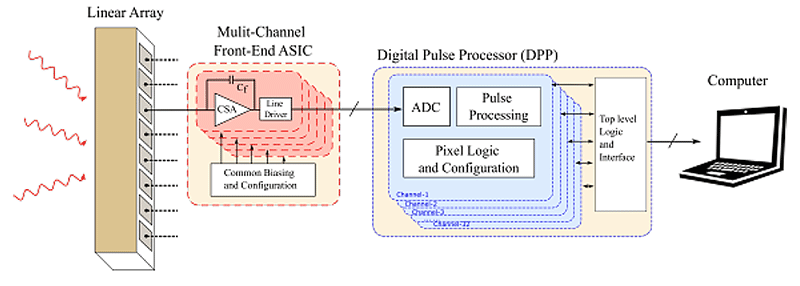
Altri partecipanti: POLIMI, UNIPA
In the last decades, great research efforts have been made in the development of X-ray imagers with single-photon counting and energy resolving capabilities because of its strong impact in numerous scientific and industrial applications: from security screening, inline food, pharma or waste inspection, non-destructive material analysis. Nevertheless, despite promising results encouraged significant investments from such industrial and research stakeholders, an X-ray scanner capable of combining at the same time a spectroscopy-grade energy resolution with a high spatial resolution and acquisition speed is currently unavailable; this absence compromises, for example, the detection capability of low-density contaminants in real-time acquisition systems for Quality Control in food and pharma industries, or strongly slows down the production. This limit mainly arises from three factors: a) a lack of a deep knowledge of the physics of detectors irradiated at very high photon fluxes; b) the speed and noise limits of the state-of-the-art readout electronics; c) the lack of a smart signal processing for high output data throughput. This fundamental research gap in theoretical and experimental studies, as well in the technological development of detectors, readout electronics and digital signal processing, represents a great open challenge toward the realization of advanced Energy Resolved Photon Counting (ERPC) Systems, able to operate at very high photon fluxes for next generation X-ray Imagers. The goal of this research project is to overcome the current limits of ERPCs by studying the above problems in their three key components (detector, electronics, signal processing), developing an innovative prototype able to operate up to 2×107 photons/s per pixel (or 50×107 photons/s/mm2) in the 2-150 keV energy range, with both high spatial (<0.1 mm) and energy (<1 keV @60 keV) resolutions, allowing a performance breakthrough in many fields of application.
The proposed ERPCS will be constituted of Cadmium-Zinc-Telluride (CZT) linear pixel arrays coupled to ultra-low noise high-speed readout electronics followed by innovative Digital Pulse Processing (DPP). The advancement of knowledge, brought by the demonstrator studied within this project, will establish a scientific and technological base for the design and development of new-generation large-format X-ray Imagers. Different industrial and scientific applications will benefit from these studies. In the case of food and pharma industries, for example, an increased capability of detecting contaminants or not compliant products can improve their production growth and safety standards: a recognized pillar in research innovation for the achievement of industrial leadership in Europe and worldwide, with a large impact on society.

This project is funded by the European Union - NextGenerationEU through the national projects call PRIN 2022









